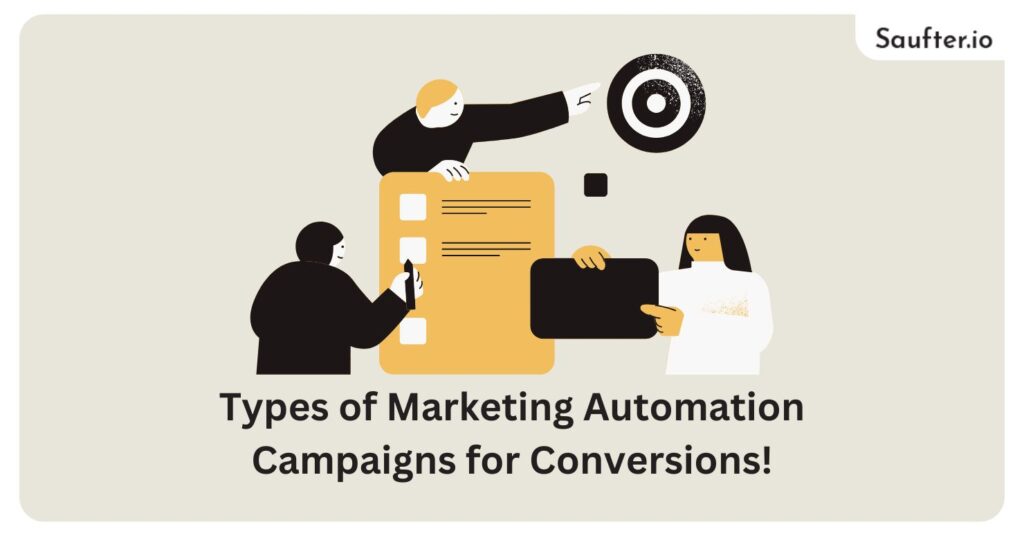Last Updated: December 2025
Marketing automation is a game-changer for businesses aiming to streamline their efforts and drive more conversions. In fact, studies show that businesses using marketing automation see a 451% increase in qualified leads.
The secret lies in crafting the right types of campaigns that resonate with your audience at every stage of their journey. From nurturing cold leads to retaining loyal customers, marketing automation campaigns are designed to maximize efficiency while delivering personalized experiences.
In this article, we’ll explore six highly effective types of marketing automation campaigns that can help boost your conversions and take your marketing strategy to the next level!
What is Marketing Automation?
Marketing automation refers to the process or technology used to automate, streamline and measure repetitive tasks associated with your marketing department. It allows companies to spend more time on creating real connections with their target audience and also helps them scale much better.
Purpose of Marketing Automation
- Streamlining Processes: By automating things such as email follow-ups, social media posting and lead nurturing manual effort is lessened which saves time and resources. It is worth noting that, automation can reduce marketing overheads by up to 12.2%.
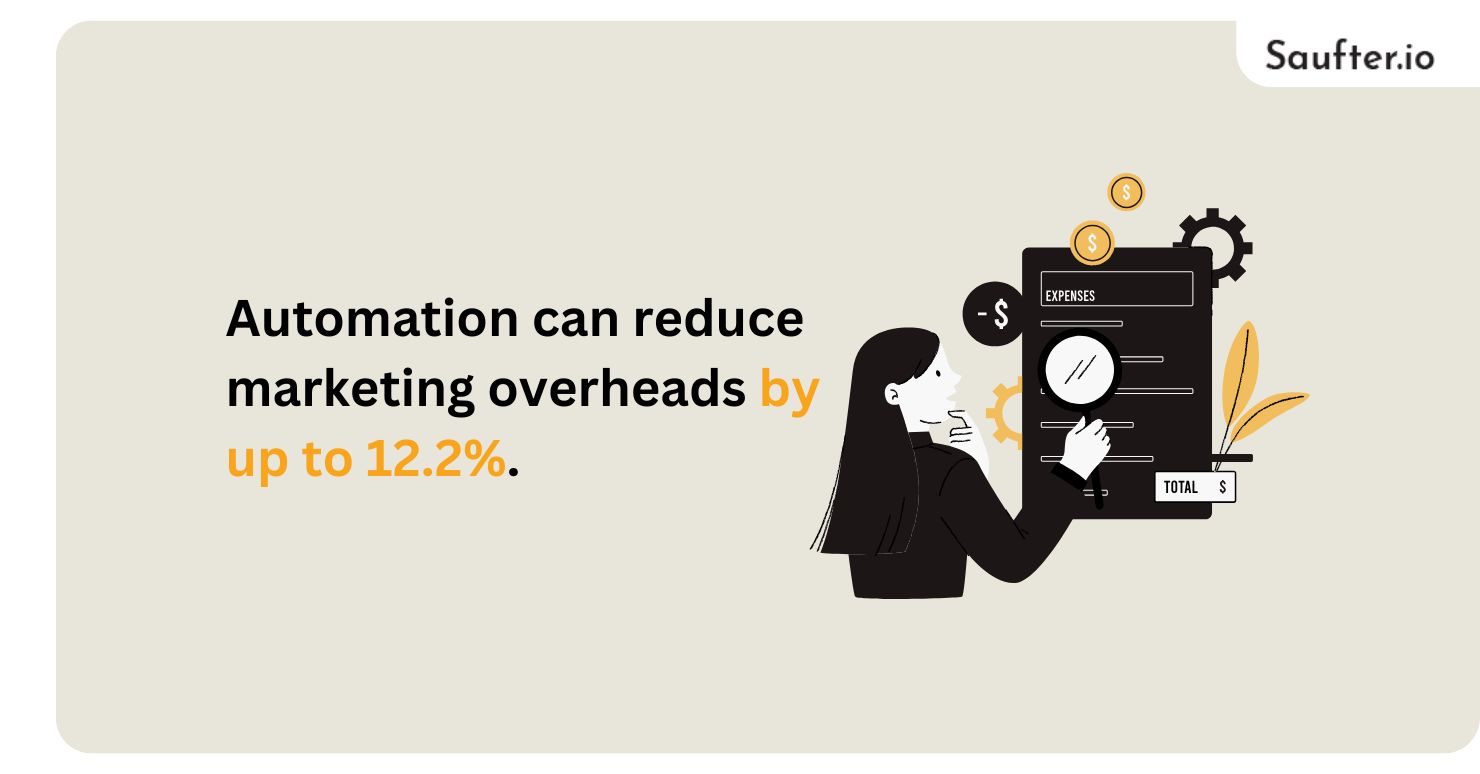
- Enhancing Customer Experience: Automation allows brands to better communicate with their audience by providing relevant and timely content.
Marketing automation allows businesses to score leads and convert customers. It helps them gain the trust of brand advocates by delivering the right message at the moment that they need it, all while doing more with less human capital.
Benefits of Marketing Automation
Smart businesses and marketers are leveraging marketing automation to deliver timely, personalized, and highly relevant messages to their audiences. These automated campaigns achieve higher engagement rates and drive significantly more revenue compared to traditional one-off messages.
Marketing automation offers several key advantages:
- Reduces repeatable tasks and provides more time for strategic undertakings. Even marketing automation tools can improve productivity by approximately 20%.
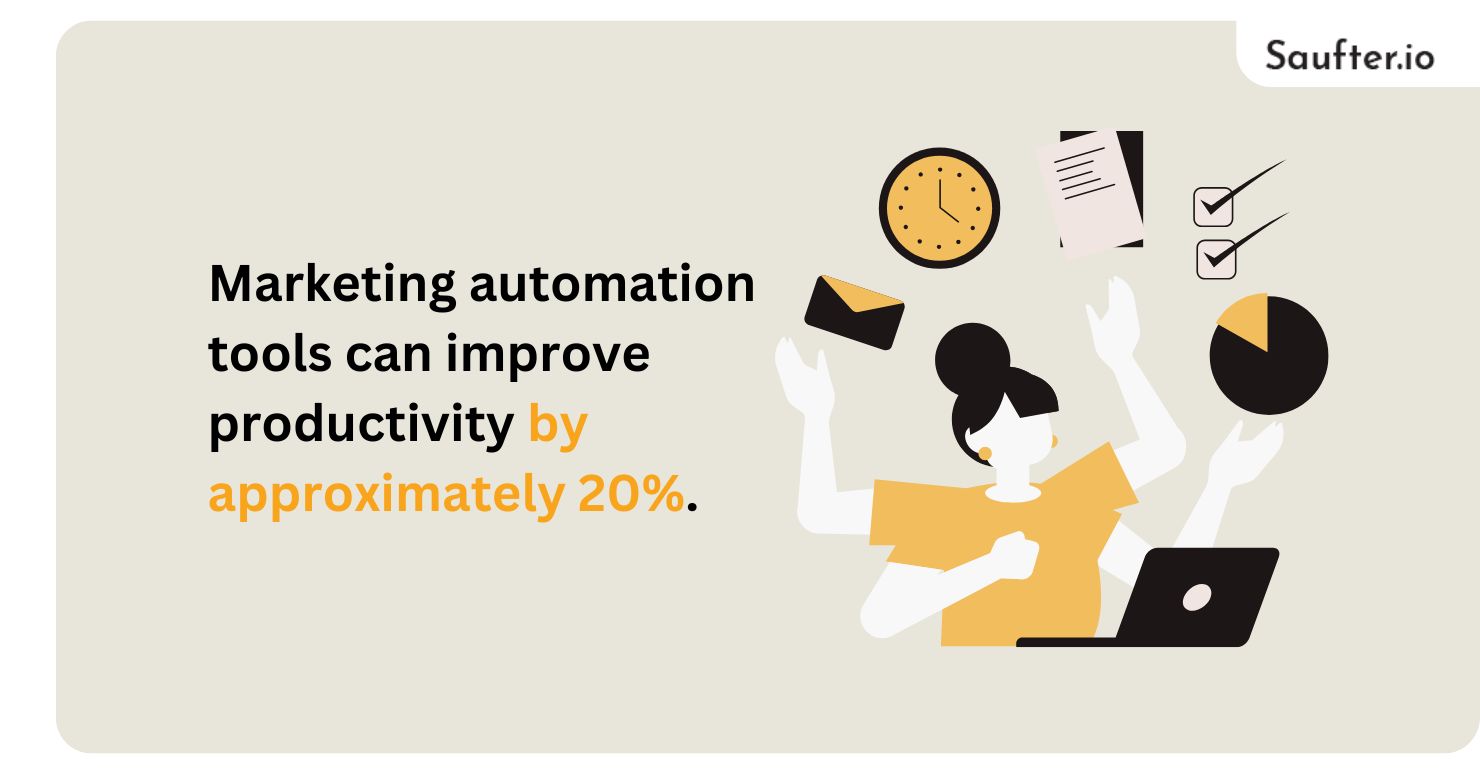
- Increases targeting potential customers and prospects.
- Enhances customer experience by providing targeted content.
- Reduces human error, as campaigns are executed in line with internal guidelines.
By automating communications, content is always delivered to the right people at precisely the time they need it. It is also what allows organizations to respond rapidly to the needs of their customers without sacrificing efficiency.
From lead qualification to post-purchase support, automation delivers a continuous process by which leads become customers.
6 Types of Marketing Automation Campaigns
Marketing automation campaigns come in various forms, each serving a unique purpose to engage leads and customers effectively. Below, we explore six essential types of campaigns that drive conversions.
1. Lead Generation and Nurturing Campaigns
The first one is Lead Generation & Nurturing Campaigns which are meant to generate new leads and nurture them down the funnel. Businesses can even use this type of automation for lead magnets like ebooks or webinars, which is a way to provide value to leads.
Follow-up drip email campaigns educate and nurture leads, keeping them engaged with the most direct communication based on their actions.
For example, a real estate company could provide first-time home buyer advice and recommend a series of properties or other content that brings the leads progressively closer to making a purchase.
2. Customer Retention Campaigns
These are responsible for making sure that all the customers who have been on your site will continue to come back and shop with you because they need what you have, even as times change.
You can use automation to deliver customized offers, subscription renewal reminders, and other rewards based on milestones.
For example, a beauty brand may automate reminders with loyalty points customers earn through repeat purchases. Campaigns like this drive down churn and increase customer lifetime value by keeping customers engaged with the brand.
3. E-commerce Marketing Automation Campaigns
E-commerce Campaigns are tailored to drive sales in online retail. Abandoned cart recovery campaigns automatically remind customers to complete their purchases, often with added incentives like discounts or free shipping.
Upselling and cross-selling campaigns, on the other hand, use purchase history to recommend related or upgraded products.
For example, an online clothing store might send a follow-up email with a 10% discount on cart items, encouraging customers to finalize their orders. These strategies ensure that no revenue opportunities are left untapped.
4. Email Marketing Automation Campaigns
Email marketing automation campaigns are a large volume of targeted and personalized messages based on specific key types. These campaigns are kicked off because of what the customer has done, such as subscribing to a newsletter or downloading a how-to guide.
Segmenting your audiences will allow you to create email content that is more tailored specifically to their needs.
Here is an example: a software company may automatically send onboarding emails to new users, which walk them through the different functionalities of their product.
It also increases engagement and opens as well, seeing click-through rates on a whole different level.
5. CRM Automation Campaigns
CRM Campaign Automation Brings together systems of record (e.g., CRM) and marketing automation tools. As for the software, businesses can integrate CRM data with their intent-based triggers so that they can fire off campaigns based on how a customer interacts.
For example, a travel agency could automate the creation of individualized trip itineraries and offers for inquiring customers. These campaigns deliver personalized customer experiences, and keep those who are most interested highly engaged throughout the buyer journey.
6. Multichannel Marketing Automation
Last but not least, Multichannel Marketing Automation Campaigns unify email, SMS and social media (and push notifications for mobile applications) in a single brand experience. With content delivery automated across channels, enterprises guarantee regular and timely communication.
A fitness app may, for example, use email to provide workout tips and push notifications to remind users of their goals whilst employing SMS only when promoting limited-time discounts on subscriptions.
Through this omnichannel approach, you not only experience wider coverage and better engagement but also remain connected with the customer at every touchpoint.
These six marketing automation campaign types can maximize businesses’ ability to successfully target leads and customers, increasing conversions while facilitating growth over time.
Marketing Automation Strategy
Do you know that 63% of companies are outperforming their competitors by implementing automation in their marketing strategy? But, to achieve this milestone, a perfect marketing automation strategy is essential.
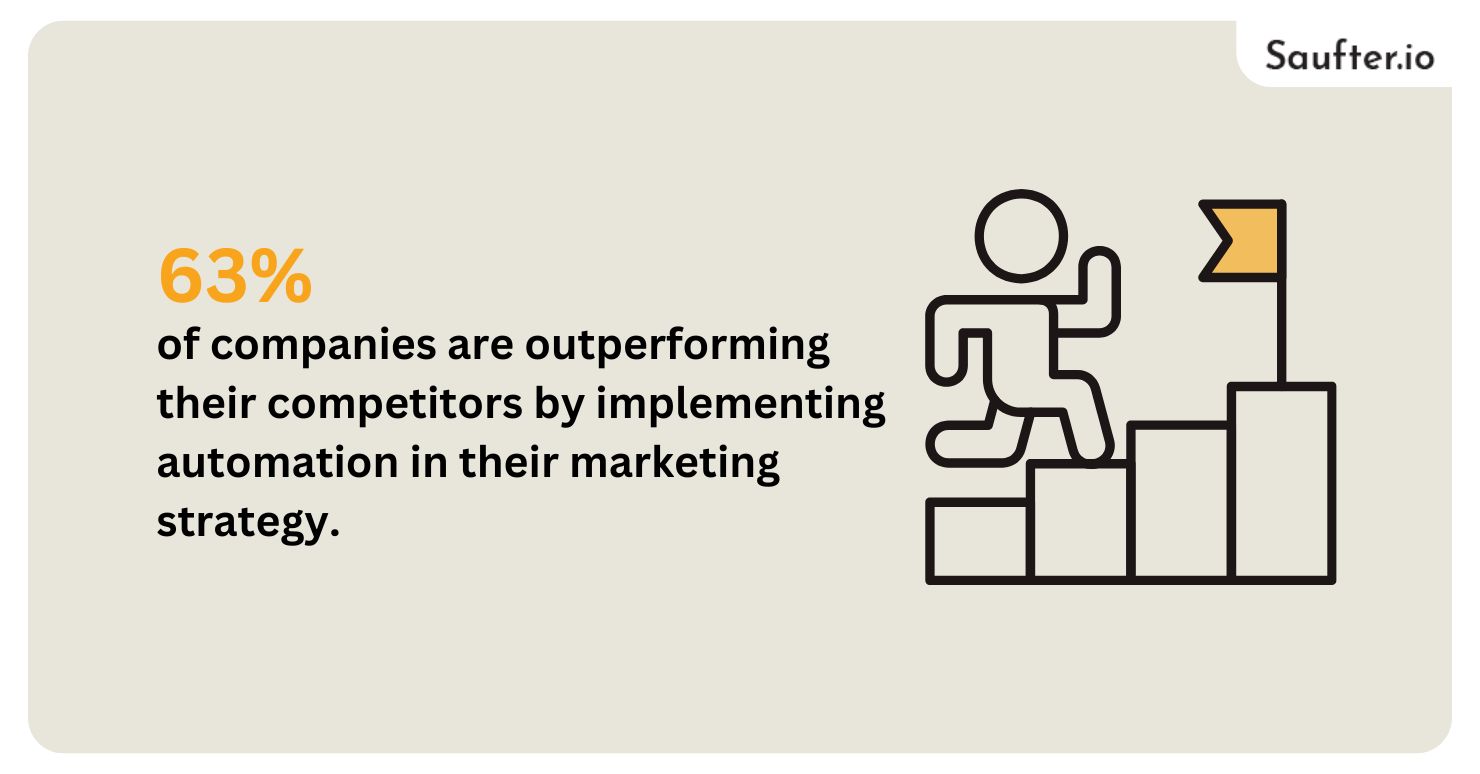
So that processes can be streamlined and customer relationships entertained in the best possible manner, making your business drive subtly.
It connects tech, data & content to deliver rich and ever more personalized experiences at scale. Here’s how to build an effective marketing automation strategy:
1. Define Goals and Map Customer Journeys
Be sure to work with clear & measurable goals, either incrementing lead generation or enhancing customer retention and sales.
Use KPIs like email open rates or conversion rates to track progress. Then, chart the customer journey in terms of key touchpoints throughout the lifecycle.
Personalize automated campaigns for the stages of awareness through loyalty, targeting your messages according to customer needs.
2. Know and Segment Your Audience
To deliver the right message, you have to know who your audience is. Segment your customers and develop detailed customer personas that include demographics, preferences, and behaviors.
Divide your target audience according to age, hobbies, purchasing preferences or life cycle stage like leads, first-time buyers or repeat customers. This ensures that every type of consumer receives the messages they need to hear in a way that is meaningful and tailored towards their group.
3. Personalize Content Across Channels
Engagement is driven by personalization. With data, tell a story that seems to be made for every recipient. Include elements like personalized subject lines, dynamic email content, and triggered messages based on user actions (e.g., cart abandonment).
Take better personalization into the features such as email, social networking, push notifications, and sms. A multi-channel methodology assures an impeccable and consistent experience with the customer.
4. Automate Campaign Timing and Execution
When it comes to your automated messages, the timing is so important beyond just what you have programmed in there. Use your user behavior and data to decide the best time for sending emails or notifications.
For example, automation can trigger an email anywhere from immediately after a sign-up to 24 hours after the user abandons his/her cart.
Finding a balance in which recipients are not overwhelmed and you maintain the interest of your mailing list without being invasive is key.
5. Leverage Data and Rules for Smarter Automation
Data and rules are the lifeblood of marketing automation. Leverage CRM or email platform customer data to inform campaign triggers.
Automate activities, for example; receive loyalty discounts after reaching a certain purchase threshold or get product recommendations based on your previous actions.
Smart automation ensures your messages are sent right on time, to the most relevant list of users being active during a particular timeframe.
6. Measure, Analyze, and Refine
Make use of analytics data to determine the ROI on your campaigns by tracking open rates, click-through rates and conversions. Find some areas for improvement, try a couple of approaches and successively refine your process. Ongoing optimization leads to long-term success and higher ROI.
Marketing Automation Best Practices
These are best practices and must-follow to gain success for your marketing automation workout. These practices help make campaigns more engaging and relevant, as they are targeting the right audience who is at a specific journey state.
The Three Pillars: Data, Rules, and Content
Marketing automation for success depends on three solid pillars — data, rules and content. Together only they can build blocks, which is essential for an effective approach to automation.
- Data: This is all information about your customer (can include mail via tools, CRM or e-commerce system). Key data points might include:
- Whether a subscriber is a customer or prospect.
- Dollars spent with your business by a customer
- Personal details like gender, birthday, job title, and product preferences.
- Rules: These are the conditions that determine the action your automation will take based on customer behavior. For example, if a subscriber exceeds an expenditure of $100, then he becomes a VIP member and gets a discount. Automation gets a dynamic reply from the rules based on user actions.
- Content: Your actual emails have to be interesting, aesthetically pleasing, and relevant to your user base. All content should be part of the customer journey and build upon the last experience.
Automations work best when aligned to map the entire customer journey. Visualize each email as one milestone on the journey, each message adding value and moving closer to the relationship.
The first act of gaining their engagement is by sending messages that are relevant to them rather than sending messages that your whole database of customers receives.
Planning the Customer Journey
If you work with automated messages, it is important to plot them out ahead of time.
To give you an example, a company selling accounting software might create a welcome email series with the goal of steering subscribers toward purchasing their product:
- Email #1: “Welcome to Accounting 101 for Small Business.”
- Email #2: “How to Think About Taxes as an LLC.”
- Email #3: “How to Hire an Accountant.”
- Email #4: “Getting the Right Accounting Tools.”
The final email would include a compelling call to action encouraging subscribers to sign up for the software.
Saufter: Best Email Marketing Automation Software

Saufter is an advanced customer engagement and emails marketing platform designed to analyze user behavior on your website or portal and their journey stages. It provides data-driven recommendations for campaigns tailored to your audience’s needs.
For instance, Saufter might suggest a “how-to” article for a feature your users haven’t utilized yet. The platform delivers fully drafted email and in-app campaigns weekly, requiring only your approval before deployment.
Additionally, Saufter monitors your competitors’ content, recommending campaign ideas inspired by their latest blogs.
Key Features:
- Automated User Segmentation: Dynamically groups users into cohorts based on behavior.
- Automated Email Campaign Suggestions: Drives better conversions and reduces churn.
- Automated SEO Campaign Insights: Offers data-backed strategies to enhance visibility.
- Conversion & Churn Prediction: Provides actionable insights to optimize engagement and retention.
Conclusion
In conclusion, marketing automation campaigns are essential for boosting conversions and building meaningful customer relationships. Research reveals that 77% of businesses have seen an increase in conversions after implementing marketing automation.
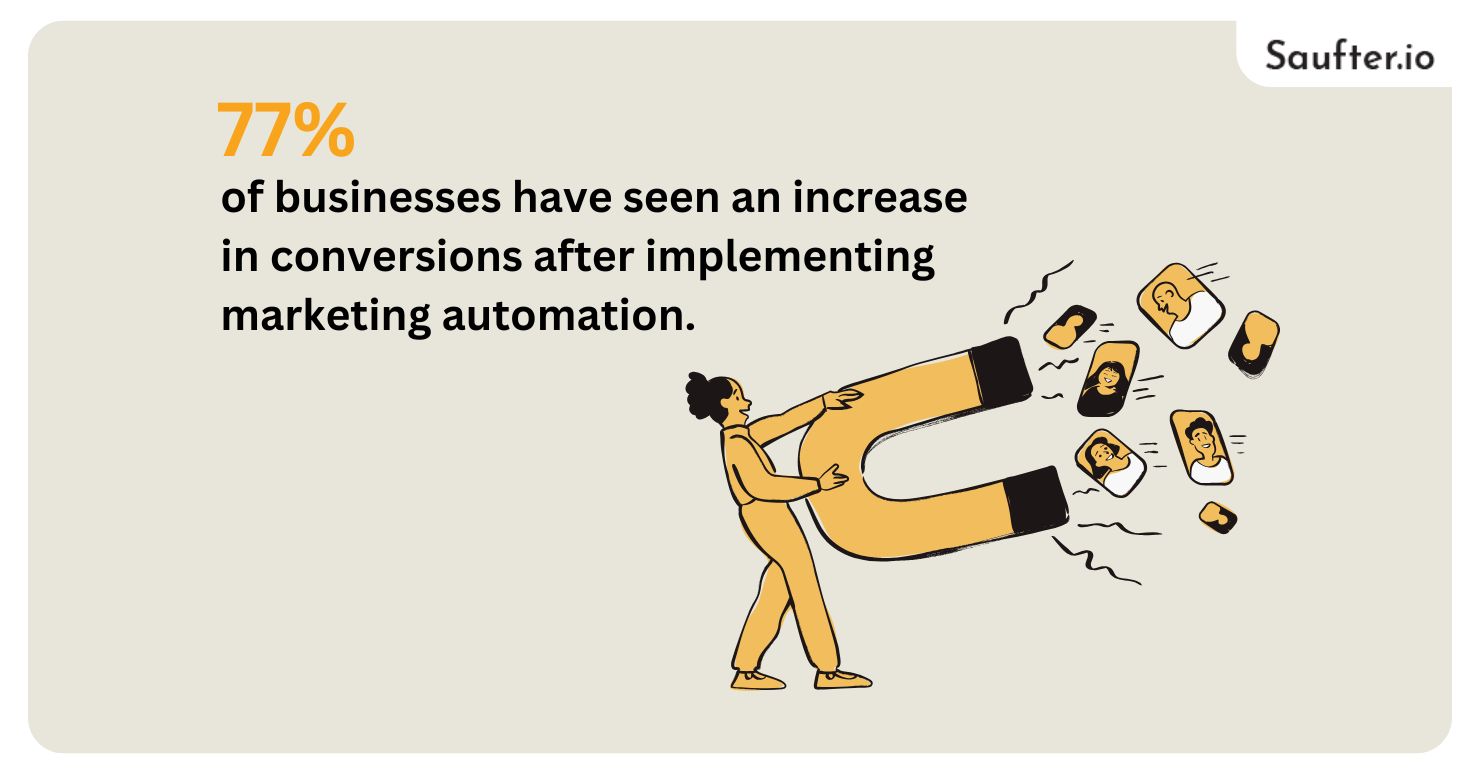
By incorporating the six types of marketing automation campaigns discussed you can streamline your processes, enhance personalization, and drive measurable results.
Tools like Saufter make it even easier by analyzing user behavior, offering tailored recommendations, and providing ready-to-use campaigns. With Saufter, you can optimize your efforts, reduce churn, and stay ahead of the curve.
Don’t wait—leverage the power of automation to transform your marketing strategy today!
